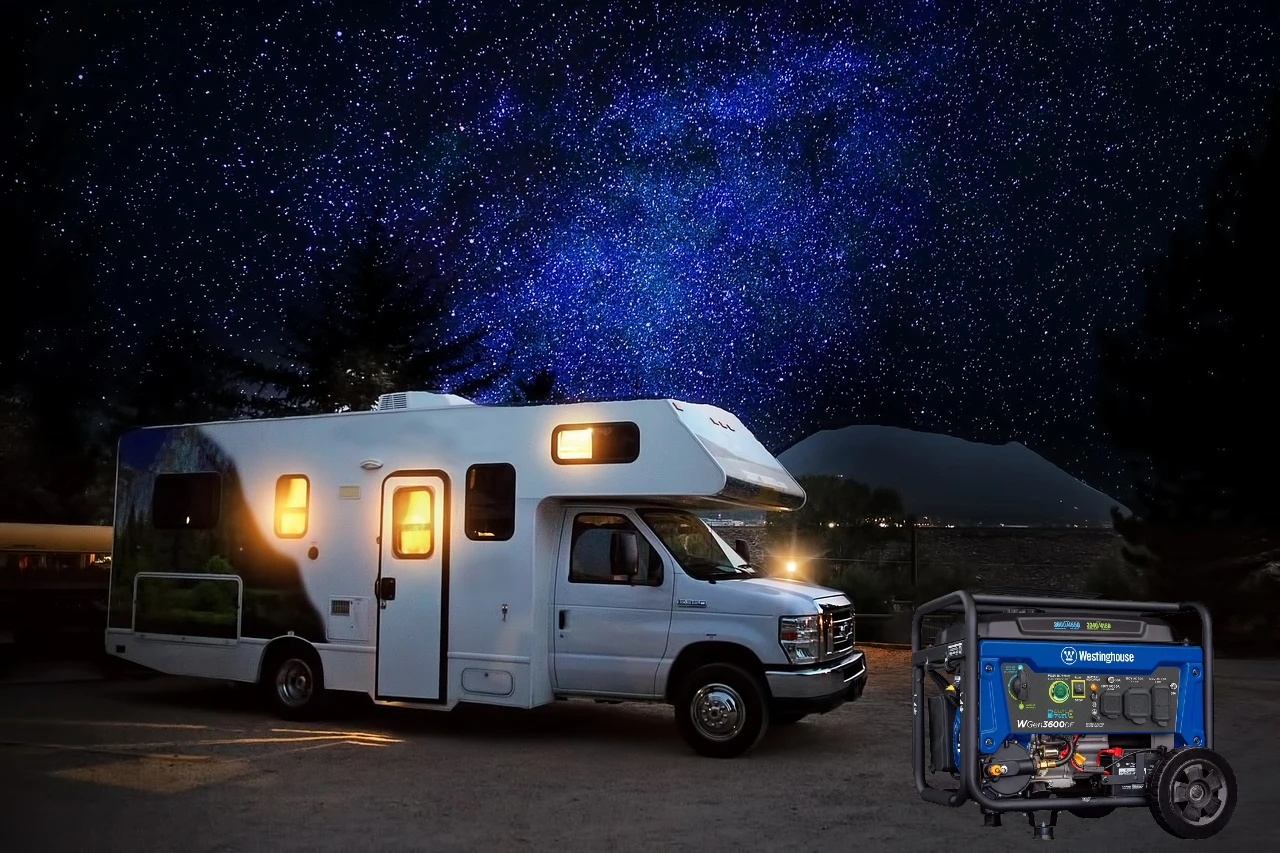USA Picnic is reader-supported. When you buy through links on our site, we may earn an affiliate commission.”
There is a tonne of 50-amp generators on the market. However, selecting the best 50-amp RV generator or emergency electricity for a job site might be difficult.
You are at the right place if you’re seeking the best solution for your power generation needs; we assure you that you will get all the information you need in this guide to help you choose wisely. To know our choice of best 50-amp generators for RV please click on this link. We’ll explore everything from power output to portability to help you select the ideal 50-amp Generator for your needs. Let’s get going!
An Introduction To 50-Amp Generators
Knowing more about the amp and how it relates to watts is crucial before learning about various 50-amp units.
Always choose a generator that is more powerful than you need when buying one for your house or RV. In a prolonged blackout, a smaller unit won’t be able to power most appliances.
A smaller generator can be adequate if you wish to run the essential appliances. However, if you plan to run large appliances, a generator with a 50-amp output is the best option.
50 Amp Generators for RV
What is most vital to think about when selecting a Genset for your RV is how you will connect it to the vehicle. A power cord is the preferred option. Either a 30-amp or 50-amp connection is possible.
Therefore, checking the compatibility of the device is always crucial. While larger models of RV use a 50 Amp connector, smaller RVs use a 30 Amp connection. You will need a 50 Amp generator for a 50 Amp RV.
To power practically anything you could need in your house, 50-amp RV generators output the same amount of electricity as any other generator with a 50-amp outlet. However, it would help if you considered when selecting the appropriate size generator for an RV, including extra features and fuel consumption, among others.
Smaller RV generators are more affordable and convenient to store but have fewer features and fuel requirements. Larger generators might have a higher output, but they can be expensive. They are additionally more challenging to maintain and store.
A portable generator: what is it?

A portable generator is a compact, independent device that generates electricity for your usage.
A generator is a device that uses the electromagnetic induction method to transform mechanical spinning motion into electrical energy or current.
A rotor (armature) spins in a stationary magnetic field, known as the Stator, of a primary electric generator to generate an electrical current.
A portable generator consists of two components: an electric generator and an internal combustion engine that spins or rotates the Generator’s armature using gasoline or propane.
Generators can produce both AC and DC power. However, for daily use, you require AC (alternating current). The size or capacity of the electric Generator and the motor connected to it determine how much power a portable generator can produce, measured in watts.
What Sets A 50 Amp Generator Apart from A 30 Amp Generator?
Each Generator’s electricity wattage is the primary distinction between the 30-amp and 50-amp generators. A 50-amp generator can handle a large load of 12000 watts, while a 30-amp generator can provide 3600 watts. Their RV designs also vary.
A neutral wire, ground wire, and wire carrying 120 volts are all on a 30-amp RV plug. A 50-amp RV plug, on the other hand, contains a neutral wire, a ground wire, and two 120-volt lines that supply two different voltages.
What Should I Consider Before Buying a 50 Amp Generator?
There are many 50 Amp generators available on the market right now. Before purchasing your next 50-Amp Generator, take into account the following things to make the process easier and save time:
Power: Low power could destroy the engine, and too much power would result in high usage. The typical range of wattages for 50-amp generators sold for home and outdoor use is between 7000 and 13000 watts, which is the ideal range.
Power Output: They built most 50-amp generators for backup power sources and outdoor use. As a result, their running wattages range from 7000 to 15000.
Power output varies depending on usage. Hence, you need to determine the total wattage of the appliances you intend to use.
Also, it would be best if you calculated the beginning watts of motor-driven appliances because they require more power to overcome inertia while starting. Then, choose a generator that is a few hundred watts more powerful than you first required.
Get a 9000 running-watt generator if you require 8000 running watts for your house or RV.
A 50-amp, 9000, or 10000-watt generator is what I would advise.
Type of fuel: Dual-fuel generators are frequently utilized all over the world. Both gasoline and propane are readily available. Gas should be your first choice if you’re looking for a whole-house generator.
You can switch to propane to run the Generator when the gas supply runs out. Therefore, opt for a dual-fuel system to save time.
Noise: You have to take a look at the noise level of the 50 Amp generator. You must take a decibel reading to understand a generator’s noise level. It is impossible to measure the noise level without a decibel measurement device.
Therefore, consult the Generator’s handbook and patent to determine the dB amount. The quieter generators are usually in the range of 60 to 78 dB.
Fuel capacity and effectiveness: Everybody desires a generator with a sizable fuel tank and one that also uses less fuel. A huge gasoline tank has a long lifespan. Most 50-amp generators have a fuel capacity of 5 to 8 gallons, with a runtime of 7 to 15 hours at a 25% to 50% load.
Some generators have an adjustable key to regulate engine speed, reducing RPM speed and saving you fuel. However, remember that a big fuel tank engine would be more challenging to maneuver.
System Start: Most generators have a dual starting method, including pull and electric starts. The battery powers the electric start mechanism. A broken battery would prevent the electric start from functioning.
Then using a pull starter with a recoil cord would be ideal. Decide on a dual-start generator and charge the battery every two to three months.
Portability: 50 Amp generators are heavier and difficult to carry with your hands. They weigh more than 130 pounds. For convenience, you could prefer a generator with wheels and a handle.
Wheels may occasionally need to be purchased individually. Within a few minutes, you may add the handle and the wheels.
What Justifies Purchasing a 50 Amp Generator?
You should get the best 50 Amp generator for several reasons to have a backup power source during outages and blackouts. These are the causes:
A 50 Amp generator generates 12000+ watts, enough to provide backup power for the entire house, fairs, events, and anywhere else. Additionally, it enables you to recharge the batteries when the power supply runs out or you don’t have access to energy.
It is a good idea to have an emergency power supply in case of outages or blackouts, especially if they linger for more than a few hours. A 50 Amp generator can protect food from spoiling in the refrigerator and power a radio so you can hear power outage updates.
All 50 Amp generators operate quietly and virtually silently. It makes it possible to work in a peaceful setting, which is beneficial if you need to recharge in a crowded public area.
A 50 Amp generator can be quite helpful in a variety of circumstances. Pick any option that best suits your needs from the list we just studied.
How is a portable generator specified?
A portable generator is generally specified by the power (watts) it produces. The two power ratings are starting watts (peak/surge watts) and running watts (also known as rated / continuous watts).
While the rated or continuous watt is available continually, a starting or surge watt is only open briefly in the beginning.
Volts, amps, and watts
Watts are measured by electrical power. The units of electric current are ampere or amp.
The force that drives the current flow is voltage, measured in volts.
Consider your bathroom sink’s tap:
- Amps represent the amount of water flowing through the pipe.
- Voltage represents the pressure.
- Watt represents the force you experience when the water from the tap hits your hand.
Watts are calculated using the equation watts=volts x amps.
Where to use a 50 Amp Portable Generator and wat are its applications?
Uses for a 50-amp portable generator include the following:
[1] Suppose your area of residence/office is prone to natural calamities, which lead to long periods of Grid-power outages. In that case, 50-amp Portable Generator will become your backup power supply and run your appliances in-home or business. However, in such a case, you must install a changeover switch and another necessary wiring to use the 50 Amps Portable Generator for your home/office backup.
[2] You can use your 50-amp portable Generator to power your construction tools and equipment if you are a businessperson working outside in an area without grid power.
[3] When you and your family go camping, you may use your 50-amp portable Generator to power your RV or other camping gear. Some 50-amp portable generators can be used with RVs, while others may require some little wiring.
[4] Your ranch or farm may benefit from having a 50-amp portable generator as a backup power source.
How To Choose the Right Size 50 Amp Generator?
You expect a 50 Amp Portable Generator to last ten years or longer, which makes it different from purchasing any other appliance.
Electrical appliances require two types of power: starting or surge watts, initially for 2-4 seconds, and continuous or running watts, which are needed for continual use.
Surge and continuous watts are the same for some appliances, such as lights and televisions. For those equipped with motors or heating coils, such as air conditioners, refrigerators, and culinary ovens, the surge watts can be as high as two or higher than its constant watts or higher.
As a result, you need to prepare a list of all the appliances you intend to use and information about their surge and continuous wattages. Let’s compile a short list of average houses and RVs separately:
Wattage Requirement for an average house
| Appliance | Running/Continuous Watts | Starting/Surge Watts |
|---|---|---|
| Refrigerator with Freezer | 400 | 1280 |
| Sump Water Pump | 300 | 1100 |
| Computer | 150 | NA (Not Applicable) |
| TV | 200 | NA (Not Applicable) |
| Lights | 60 | NA (Not Applicable) |
Method 1: Add the highest starting watt, 1280, to the other running watts – (1280+300+150+200+60) = 1990 watts. Little more than 1990 means you can choose a Portable generator with starting watts of 2000.
However, you should connect your refrigerator before gradually adding the other equipment. The same caution must be taken when turning the fridge off.
Method 2: To start the refrigerator and pump simultaneously, add the total starting watts of 2380 to the remaining running watts- (2380+150+200+60) = 2790 watts.
A portable generator with a starting wattage of 2000 is insufficient in this situation. If you try to use one, the overload circuit breaker will trip. Choose a portable generator that has more beginning watts than 2800.
You may find your products’ starting and operating wattages in the product manual. If you can’t find it, ask an expert or someone with a wattage meter for assistance.
| Appliance | Wattage |
|---|---|
| RV Air Conditioner | 2000 Watts |
| RV Refrigerator | 600 Watts |
| Electric Stove | 2000 Watts |
| Microwave Oven | 1500 Watts |
| Coffee Maker | 600 Watts |
| Hairdryer | 1500 Watts |
| Laptop | 200 Watts |
| TV | 200 Watts |
| Total Wattage Requirement | 8600 Watts |
Take into account that you must run each appliance for eight hours daily.
Let’s enter the variables into the formula to determine the size of the 50-amp RV generator.
Generator Size = (8600 x 8 x 120%) ÷ 90% = 9.1 KWH
Finally, a 9.1 KWH generator is sufficient to power a 50-amp RV. Additionally, since you won’t be using every appliance at once, you can use them for longer than 8 hours.
Which Fuel Type is better for a 50-amp generator?

Before acquiring a 50-amp generator, fuel is one of the most critical components to consider. Diesel or natural gas is the fuel type typically used to power generators. However, it would help if you thought about which fuel would be ideal. Depending on your needs, you need to buy a 50-amp generator to power your homes.
A specific fuel can only power some generators. While gas and propane are often the most popular, some may also use diesel.
The number of generators that can run on one or two different fuels is also relatively large. Typically, diesel generators are somewhat hard to find.
It’s crucial to remember that the price of some fuels can vary greatly, so you should consider how affordable your fuel type will be over the long run.
You also want to look for a generator that uses the same fuel as your RV. This will help to switch gasoline if necessary because you can purchase fuel for both varieties.
Propane generators typically have the added advantage of lasting longer than gas or diesel generators. That said, you will need to consider whether a propane refilling station will be available.
How much noise does a 50-amp generator make?
Every Generator, it should go without saying, will inevitably produce some noise. However, the amount will vary for every Generator.
The vast majority of contemporary generators employ Quiet Technology, which lowers the amount of noise they may produce. The Durostar is your best option if you want to get a quiet portable generator with a 50-amp RV plug.
With this Generator, there can still be some noise; however, it won’t likely be as loud as other possibilities.
Most 50-amp generators will, on average, produce noise between 55 and 70 decibels. This sound could be a little annoying if your Generator is inside your home or in a crowded RV park.
However, the Generator is in Eco Mode if it operates between 25 and 50 percent of its capacity. Eco Mode will result in far less noise than usual.
The Generator will produce significantly more noise when used at total capacity than what the manufacturer’s standards call for. In conclusion, noise output is one of the most crucial aspects to consider when choosing your Generator.
I am sure you do not want your neighbors to complain that your noisy Generator kept them up all night. To prevent yourself and your family from being irritated, get a generator that creates a level of noise you can tolerate and attempt to keep it hidden while not in use.
Do RVs Require Inverter Generators?

Through high-frequency technology, inverter generators transform AC power into DC power and back to AC power. This method avoids power sags and cleans electricity with a Total Harmonic Distortion (THD) range under 5%.
An alternator, an inverter, and a battery make up inverter generators. Typically, they produce power at a rate of 120 Volts at 60 Hertz.
For RVs, you can use both traditional and inverter generators. Because of their unique qualities, most RV enthusiasts prefer inverter generators. These features are better suited for outside activities like tailgating, RV camping, and other outdoor purposes than for operating heavy machinery on construction sites. Both traditional and inverter generators are available for homeowners.
The following characteristics make inverters the best option for RVs:
Mobile phones, tablets, and laptops may all be charged safely using energy with a THD of less than 5%.
Its quiet functioning makes it appropriate for use in tranquil and natural settings, as well as campgrounds and RV parks.
Because they are lightweight, they are simple to transport, whether taking a picnic or RV tour.
Two inverters can be connected to an RV once if you want to run more appliances.
What Sets an Inverter Generator Apart from a Regular Generator?
Standard generators operate at total capacity to generate electricity. The engine’s throttling up and down creates electricity for the inverter. Increased fuel economy is the outcome.
Type of current produced:
Conventional generators produce AC electricity, but inverter generators convert AC to DC and back to AC to produce electricity.
The inverter can now produce clean energy with low harmonic distortion (less than 5%) thanks to creating a sine wave during this conversion.
The uneven sine waves produced by traditional generators result in significant harmonic distortion. Large appliances are comparatively safe but can harm delicate electronics with microprocessors.
Power Output: Compared to inverter generators, conventional generators produce more energy. It results from the different mechanical designs and motors employed in both. The size of the fuel tank has an impact on the Generator’s ability to generate power.
The typical power range for inverter generators is 1200 to 4000 watts. However, standard generators are capable of producing more than 10,000 watts.
Fuel Economy: Inverter generators are distinguished by their energy and fuel-saving characteristics. During the generation of power, inverters use less fuel and also modify for your RV’s energy requirements. Consequently, they have smaller gasoline tanks.
Traditional generators don’t have any energy-saving or fuel-saving features. They weigh more than inverter generators because they have more giant fuel tanks.
Portability: Conventional generators weigh more and are more prominent than inverter generators. People who travel extensively by RV know how difficult it is to transport a large, hefty generator. Inverter generators are the best option for RV life, camping, and tailgating.
Due to their tiny motors and fuel tanks, conventional generators are lightweight and compact. Their handle can easily pull them along.
Noise: Despite introducing numerous noise-reducing features, traditional generators will always be noisy. It’s because of the way they work.
In comparison to conventional ones, inverters generate comparatively little noise. They thankfully operate to their smooth 3600 RPM operation quietly.
Parallel Connection: A parallel connects two or more generators; it is possible when employing inverter generators. You can use two inverters simultaneously using the parallel connection to get twice the power. Conventional generators do not have this feature; therefore, you should purchase one only after carefully analyzing your needs.
Gas emissions from generators may have a considerable impact on the environment. The gases are only very minimally released, as indicated by EPA and CARB compliance.
Cost: Inverter generators are more expensive than traditional generators. The inverter generators are practical and adaptable because they are constructed using the latest technology and include the newest features.
| Feature/Characteristic | Conventional Generators | Invertor Generators |
|---|---|---|
| Power Output | Greater than invertors | Less than conventional |
| Fuel Efficiency | No | Yes |
| Clean Energy | No | Yes |
| Weight | Heavier | Lighter |
| Noise | Produce Loud Noise | Produce low noise |
| Parallel Connection | No. Only One Generator can operate at a time | Two inverters can be connected |
| Price | Cheaper than invertors | More expensive |
Are 50-amp generators safe?
When the pole electricity is unavailable, inverter generators are handy, portable devices utilized as backup power sources. When not handled carefully, generators can become dangerous and even harmful. Please find below some tips to protect your family and yourself.
Electrical risks: Generators must be connected to your electrical system, which poses serious risks if not used properly. Ground your generators and install a ground fault circuit interrupter (GFCI) to ensure that electricity is cut off immediately.
Please don’t use the Generator’s power capacity to overwhelm it. Your appliance will suffer damage, and there’s a chance it’ll also catch fire. Never connect a generator to a wall socket since this can result in back feeding, which will be disastrous for your neighbors and the electricity grid.
It would help if you fueled the Generator while it is running, and you must turn it off before refueling. To avoid fire mishaps, store the gasoline in sealed containers far from machinery.
Most people aren’t aware that portable generators release a gas called carbon monoxide, which is colorless and odorless. Carbon monoxide can be lethal or sickening if ingested in large enough doses.
Over 900 people have died from carbon monoxide poisoning while using portable generators in the last fifteen years, and at least 15,500 more have sought treatment in hospital emergency rooms. Because they installed the generators indoors with insufficient ventilation, most of these carbon monoxide poisoning episodes occurred.
Manufacturers currently include the Auto shut-off feature in the new inverters. The sensors promptly shut off the Generator if there is a build-up of gas outside the immediate area.
Verify the Generator’s carbon monoxide safety features before purchasing. You shall find generators marked with “CO Guard,” “CO Protect,” “CO Shield,” or other corresponding markings.
Conclusion
It’s crucial to pick a generator that is ideal for your requirements. Even though some generators are for commercial usage, a good Generator should be simple to operate, effective, and powerful.
You must take into account both the Generator’s price and its wattage while purchasing one. This information will be beneficial when buying a 50-amp generator.
You will benefit from knowing what is required to power up your appliances. This article will be helpful for folks with large RVs or those who want to use their generators for various tasks.
You Might also like to Read
Best Septic-Safe Toilet Paper – Septic Safe Vs RV Toilet Paper
Best Tent Air Conditioner – How to Use and Choose
Hanging Tents – How to Create the Ultimate Camping Experience



